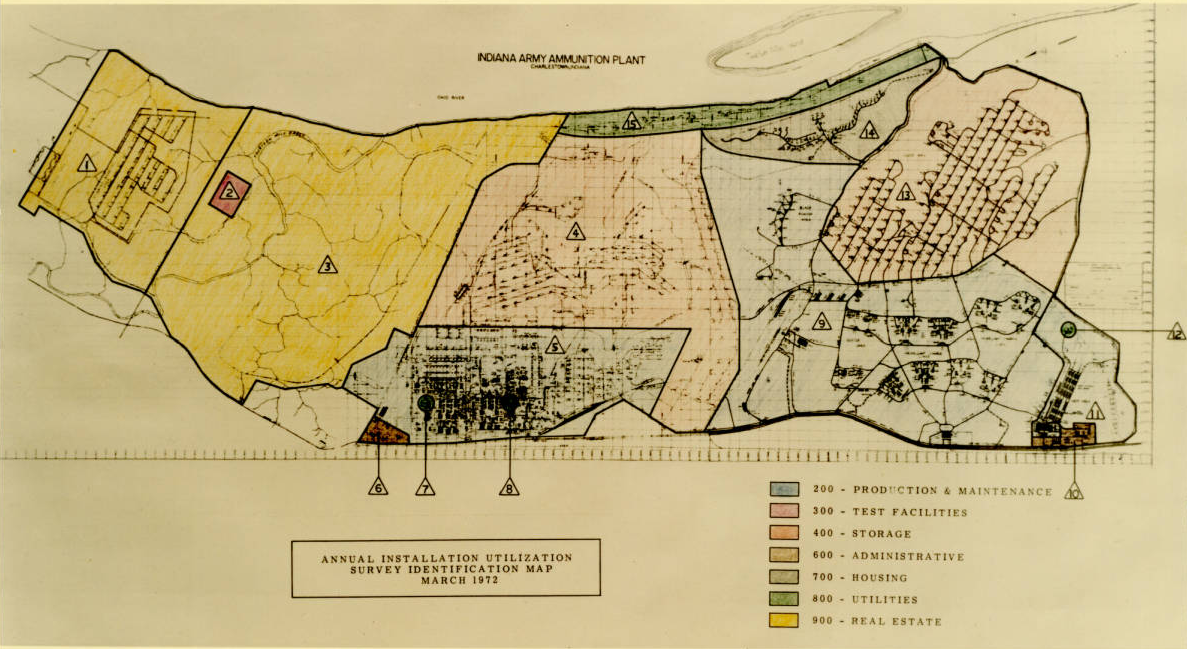The Library's Collection of Artifacts and Brief History of
|
Indiana Ordnance Works Indiana Arsenal |
Hoosier Ordnance Plant Indiana Army Ammunition Plant |

Charlestown-Clark County Public Library owns a large collection of document, photographs, maps, manuals, files, newsletters, and artifacts from Indiana Army Ammunition Plant. Thousands of these items have been digitized and can be seen on Indiana Memory in the Clark County Collection. On Indiana Memory, searching INAAP will pull up all items related to the powder plant.
Links to many of the digital images of the items are provided below with the history of the plant. As more items are scanned, they will be added to the digital collection.
A Brief History of Indiana Army Ammunition Plant
Beginning in late 1939, the US federal government began a search for property in Clark County, Indiana to build an ammunition manufacturing plant to supply the US military if the US became involved in World War II. Charlestown was selected based on its interior location in the country, water supply, labor supply and railroad access.
Land Acquisitions
In 1940 the farmland in Charlestown located between Highway 62 and the Ohio River and south of Charlestown Landing Road was purchased by the federal government. About sixty families had to move.
The second land acquisition of 4,800 acres happened in January 1941. This land was to the south of the first acquisition stretching down into Utica Township. It contained about fifty farm houses and thirty-five summer cottages.
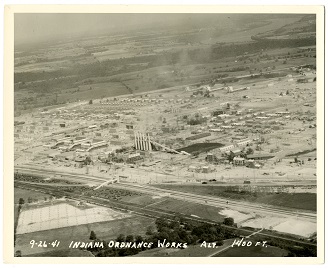 Included on this land were several businesses, the Clark County Poor Farm (which was closed in 1941 and used as a gentleman's club for plant employees), a few churches and 17 cemeteries. There were caves openings located in this area. The Army blasted them closed in case they were linked to openings outside the plant.
Included on this land were several businesses, the Clark County Poor Farm (which was closed in 1941 and used as a gentleman's club for plant employees), a few churches and 17 cemeteries. There were caves openings located in this area. The Army blasted them closed in case they were linked to openings outside the plant.
The third and final land purchase was in 1944 of the land north of Charlestown Landing Road. This area included several farm houses and the old Rose Island amusement park located on Devil's Backbone at Fourteen Mile Creek.
• Indiana Ordnance Works Real Estate Acquisition 1941, Charlestown, Indiana
• Indiana Ordnance Works warranty deed 30 Jan 1942, Charlestown, Indiana
• Indiana Ordnance Works Real Estate Acquisition Plant 2, 1945, Charlestown, Indiana
• Indiana Ordnance Works - B&O Railroad - Eligah Strong Property Acquisition, Charlestown, Indiana 1945
Construction and Beginning of Manufacturing
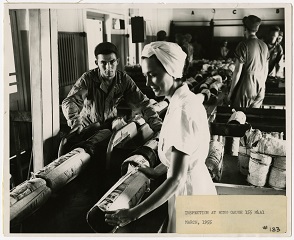
When the project began, the Constructing Quartermaster of the US federal government was in charge. Before construction was completed the Army Corps of Engineers replaced the Constructing Quartermaster.
E.I. du Pont de Nemours & Company was contracted to build and run the smokeless powder plant in June 1940. This plant would be known as Indiana Ordnance Works and was located on the first land purchase.
Soon after, Goodyear Engineering Corporation was contracted to operate a bag loading facility adjacent to the south side of the powder plant. Winston Bros., Haglin, Missouri Valley and Solitt Construction Company was contracted to build the bag plant. This plant was called Hoosier Ordnance Plant and was located on the second land purchase. Facilities of this type are known as government owned, contractor operated (GOCO) facilities.
• Indiana Army Ammunition Plant maps
Indiana Ordnance Works (IOW) Plant 1 was built by du Pont to produce smokeless powder. Construction began 26 August 1940. Production began 11 April 1941 before construction was complete. The construction of the plant had 3 shifts in order to finish as quickly as possible. Brick, concrete and steel were used to make this a permanent facility. It was completed 31 December 1942. This plant cost $107,649,582 compared to the original estimate of $31,000,000. Original plans called for 2 powder production lines but was increased to 6 lines during construction. There were 619 permanent and around 100 temporary buildings. It was the world's largest powder plant. Production ended 5 October 1945 and it was made a standby facility.
• The Action 1941 - the first employee newsletter for the facility
Hoosier Ordnance Plant (HOP) was a bag manufacturing and propellant charge loading facility built and operated by Goodyear. Do to cost over runs with IOW, it was decided that more cost saving materials would be used to build HOP. No more brick buildings were built. Roads and railroads were made lighter. The cost cutting measures at IOW/HOP influenced all future munitions plants built in the country.
On 10 January 1941, construction began on HOP. The first charges for the 105 mm howitzer were produced on 2 September 1941. By the end of 1941, the facility was in full operation. The main building for this facility was a 4-acre single story building. It had hundreds of sewing machines with about 1000 workers. The facility was so efficient that IOW powder production could not keep up. Production ended 15 August 1945. It was declared a standby facility. In February 1946 it was put in layaway status.
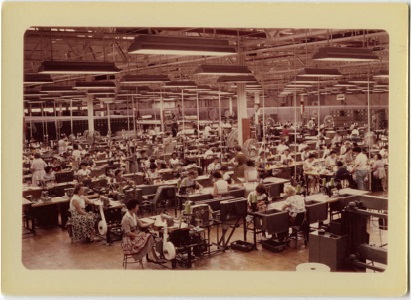 On 8 December 1944, IOW Plant 2 construction began on the land north of IOW Plant 1. DuPont was the contractor. It was built to manufacture rocket propellant. The construction was never completed due to the surrender of the Japanese on 13 August 1945. It is said that workers were told to "lay down tools and go clock out, you will be notified when to pick up your final check." Although the facility was never completed, it did produce some double-base rocket propellant in July and August 1945. It was put on standby status 11 February 1946. After the war, 5,000 acres of Plant 2 were declared excess and sold. The magazine storage igloos were used until June 1961. Another 1600 acres were declared surplus and put up for sale in May 1963.
On 8 December 1944, IOW Plant 2 construction began on the land north of IOW Plant 1. DuPont was the contractor. It was built to manufacture rocket propellant. The construction was never completed due to the surrender of the Japanese on 13 August 1945. It is said that workers were told to "lay down tools and go clock out, you will be notified when to pick up your final check." Although the facility was never completed, it did produce some double-base rocket propellant in July and August 1945. It was put on standby status 11 February 1946. After the war, 5,000 acres of Plant 2 were declared excess and sold. The magazine storage igloos were used until June 1961. Another 1600 acres were declared surplus and put up for sale in May 1963.
The total acreage of the 3 plants was 18,169.41 acres. There were over 1700 buildings, 190 miles of roads and 92 miles of railroad track.
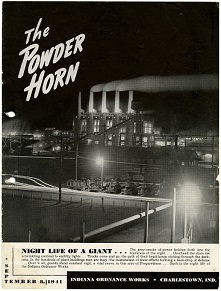
The library has copies of almost all of The Powder Horn, an employee newsletters of Indiana Ordnance Works. It was published between 1941 and 1943. The Hoosier Clan was the newsletter for Hoosier Ordnance Plant. Clark County Museum in Jeffersonville, Indiana provided this item for scanning. These two newsletters contain stories about the plants, its employees, the war, poetry, jokes, human interest stories and more. These are a great resource to learn about what it was like in Charlestown at the time.
• The Powder Horn 1941-1943 - employee newsletter for Indiana Ordnance Works
• The Hoosier Clan (some issues from 1942-1943) - employee newsletter for Hoosier Ordnance Plant
Jefferson Proving Ground
Located 35 miles to the northeast of IOW/HOP in Madison, Indiana, Jefferson Proving Ground was built in 1940-1941. It was used as the testing ground for the ammunitions produced in Charlestown. The facility went into standby 23 August 1946. Later it was reactivated. It was officially closed 30 September 1995. Approximately 50,000 acres of the grounds was leased to the United States Fish and Wildlife Service in 2000 to be operated as Big Oaks National Wildlife Refuge. In 1998, a 1,033-acre parcel of land became an air-to-surface gunnery/bombing range by the Indiana Air National Guard. As of 2014, Jefferson Range is used for UAV training, including tests of air-to-ground strikes.
Population Explosion in Charlestown
Such a large construction effort required a large work force. Charlestown (population 936 on the Census of 1940) became a boomtown overnight. Trailer camps popped up all over town. Every garage, shed and chicken coop were being rented as apartments. Some beds were rented twice a day that would be once for a day shift worker and once for a night shift worker. By the spring of 1941, the population was over 3,000. Most of the work force had to take up residence in nearby cities.
• Boomtown Plant Works So US Guns Can Boom by Red Fleming 1941 poster
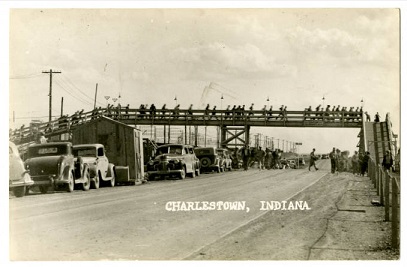
Charlestown was overwhelmed. The small town appealed to the State Defense Council of Indiana for assistance. Zoning ordinances were created. Building codes adopted. Traffic laws put into effect. The roads were not paved. Public services such as police, fire, sewers, water, garbage removal, mail delivery, recreational programs, and schools had to be improved. The town needed more of everything to supply the thousands of people that showed up. This all led to a large increase in the number of businesses opening in town.
The workers came from all over the country as word spread about the job opportunities. People would drive from as far away as 50 miles each day to work. They were brought in by the bus loads from nearby cities. The B&O Railroad which ran along Highway 62 provided another source of transportation to the plant.
Traffic jams became the normal way of life. At the start of the project, Highway 62 was a 2-lane paved road. In 1941, it was rebuilt into a 4-lane divided highway. Cars had to be parked outside of the plant on the west side of Hwy 62 causing the workers to have to walk across the highway to get to work. The solution was to build 2 pedestrian bridges over the highway. Later a third pedestrian bridge was built over the highway just north of the intersection with Highway 3.
• Charlestown 1941 Highway 62 Progressive Traffic Treatment report
A federal housing project neighborhood was built in Charlestown off of Highway 3 at Clark Road. The neighborhood was named Pleasant Ridge. It consisted of 750 Gunnison prefabricated homes. The homes were rented to employees of the manufacturing plants.
• Photographs and documents of Pleasant Ridge neighborhood
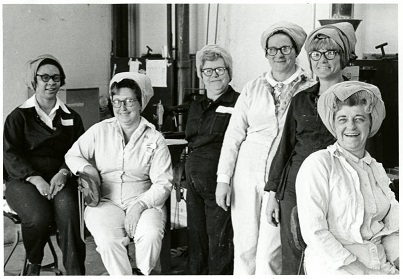 Employment Numbers
Employment Numbers
• Indiana Ordnance Works map showing source of labor supply, 7 Jun 1941, Charlestown, Indiana
It was said that at one time in 1942, as many as 50,000 people were employed at the facility either in the construction of the plants or working on the production lines. As construction ended, layoffs came in large numbers. Many of the construction workers took on jobs in the manufacturing facilities.
Peak employment on construction was 27,154 workers. At its peak, IOW Plant 1 employed 9,442 workers in the production of smokeless powder. HOP employed 8,902 production workers at its peak in May 1945. IOW Plant 2 construction had 17,585 workers and also utilized the German POWs. Large portions of the workforce on the production lines were women.
German Prisoners of War in Charlestown
Labor was in short supply. The army had considered bringing in Jamaican workers which they had done at other facilities. Instead, roughly 1000 captured German soldiers of Rommel's Afrika Corps were brought to the plant on 19 May 1945. They were marched up Hwy 62 from the Quartermaster Depot in Jeffersonville, IN. The POW camp was located in IOW Plant 2 at the north corner of Hwy 62 and Charlestown Landing Road. (The library has a blueprint of the layout of the camp.) The POWs were used in some of the construction of IOW Plant 2. Many of the POWs were used as farm labor for local farmers. They were returned to Germany after only spending a few months at the camp due to the surrender of the Japanese.
• Indiana Ordnance Works & Hoosier Ordnance Plant statistical report 1939-1945, Charlestown, Indiana
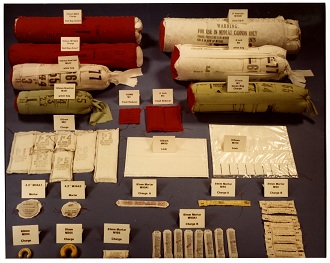
Post World War II
On 30 November 1945 at the end of WWII, the three plants were combined and renamed Indiana Arsenal. Many of the buildings in IOW Plant 2 were demolished. About half of the land in IOW Plant 2 was sold off as surplus.
Starting 26 June 1946 to 31 March 1950, DuPont was contracted by the government to operate the acid facility to produce ammonium nitrate aqueous solution for agricultural purposes. Spencer Chemical Company leased the facility after DuPont to make ammonium nitrate.
Korean War Era
A new contract was signed with DuPont on 3 January 1952 for the rehabilitation, reactivation and operation of the IOW Plant 1 facility to supply ammunition for the Korean War. Employment was at 8,067 in August 1953. This lasted until 30 September 1957 at which time it was put in standby status again until 1 March 1959. Approximately 50 new buildings were built at this time.
In 1950 HOP was being used for bag manufacturing again. Goodyear acted as consultants from April 1951 to July 1952 at which time Goodyear signed a new contract to operate HOP again during the Korean War. Production ended on 20 September 1957 at which time the facility was put in layaway status.
Vietnam War Era
Liberty Powder Defense Corporation (LPDC) was established 29 October 1959 by Olin Mathieson Chemical Corporation to take over management of the facilities. Partial reactivation happened on 23 August 1961 when LPDC began producing cloth bags for 105MM artillery charges.
In June 1960, 67 acres of IOW Plant 1 along Highway 62 were given to Clark County for use as the 4H County Fair Grounds. This land also included the land with the Poor Farm building.
The plant was reorganized and designated Indiana Ordnance Plant. It held this designation between 1 November 1961 and 1 August 1963. Olin dissolved their subsidiary LPDC on 31 December 1961. Olin then took direct charge of plant operations. This coincided with the reactivation of the igniter and propellant load lines. The black powder was being supplied from other munitions locations.
• Indiana Army Ammunition Plant historical monograph 17 July 1940 - 1 July 1963, Charlestown, Indiana
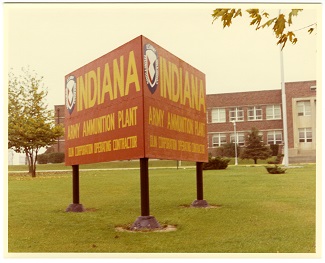
Another name change came 1 August 1963 when the facility was designated Indiana Army Ammunition Plant (INAAP). This is the name most commonly associated with the facility regardless of the time period being referred to.
• Indiana Army Ammunition Plant overview & timeline 1940 to 1970, Charlestown, Indiana
• INAAP AMC installation and activity information summary 9 July 1971
Imperial Chemical Industries (ICI) Americans, Inc. took over as the facility operating contractor from Olin on 1 May 1972. This company managed other similar facilities.
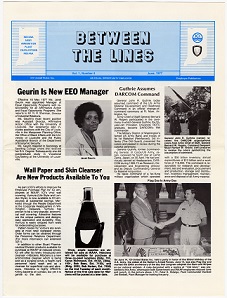
There are a variety of employee and facility newsletters/bulletins that ICI produced at the time they managed the facility.
• INAAP Weekly Bulletin Nov 1971-Dec 1973
• INAAP Bulletin Jan 1975-Oct 1975
• INAAP Quarterly Reports 1976
• The Hoosier News 1972-1981
• Between the Lines 1977-1992
• History of Indiana Army Ammunition Plant 1973
• INAAP Installation Real Property Utilization Survey 1973
New Production Facilities
At the end of the Vietnam War in 1975, the federal government set out to modernize its munitions manufacturing facilities.
• Welcome to Indiana Army Ammunition Plant, c1975, Charlestown, Indiana
• Indiana Army Ammunition Plant building locator LAP area, June 1977, Charlestown, Indiana
• Indiana Army Ammunition Plant building locator P&E manufacturing area, June 1977, Charlestown, Indiana
• Indiana Army Ammunition Plant - DARCOM Installation and Activity brochure 31 Mar 1978 Charlestown, Indiana
• Indiana Ordnance Works Plant 2 timeline, 1979, Charlestown, Indiana
• Indiana Army Ammunition Plant installation description March 1979, Charlestown, Indiana
• Black Powder Manufacturing Facility at Indiana Army Ammunition Plant, Charlestown, Indiana 1982
In 1982, a new Black Powder Plant was built in the southwest corner of IOW Plant 2 near the Ohio River. This plant cost $35 million. It was designed to produce 500,000 pounds of class I military grade black powder per month. Operation of this plant only lasted one year due to its efficiency in producing black powder and the decrease in need due to changes in modern warfare. It was put in standby in the summer of 1983.
• The Powder Plant at Charlestown by Dave Hackel, c1985 Charlestown, Indiana
• Indiana Army Ammunition Plant Historic Properties Report, draft April 1984, Charlestown, Indiana
In October 1988, construction of the M67 105mm propellant charge loading facility was completed. It was created on the site of the old Load Line 1 in HOP at a cost of $26 million. Additionally, a center core charge was constructed for 155MM propellant charges. It was built at the northeastern most igniter charge line in HOP and was completed around 1986.
• Large Caliber Propelling Charges brochure 1987, Indiana Army Ammunition Plant, Charlestown, Indiana
End of the Plant and New Beginning for the Land
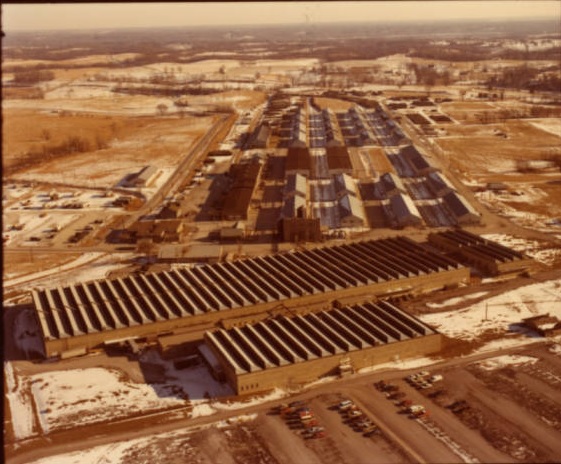
The production of ordnance continued at the plant until October 1992. The facility was officially put into modified caretaker status. This meant that it was being kept in a way that it could be put back into production if needed. ICI was still the operating contractor at this time.
• Indiana Army Ammunition Plant legal description, 22 May 1992 Charlestown, Indiana
• Indiana Army Ammunition Plant 1940-1945 historic context, appendix J, 1992, Charlestown, Indiana
• History of Indiana Army Ammunition Plant by J.J. Brown, 1992 Charlestown, Indiana
After the ammunition plant was closed in 1992 the federal government implemented a program to lease the land and facilities at places like this to keep them from setting idle. In 1993 the plant operations were officially transferred from military to civilian control. ICI remained the operating contractor and began finding tenants to lease the land and buildings.
• Indiana Army Ammunition Plant map 1993, Charlestown, Indiana
• INAAP promotional materials
Then in 1995 the plant received its final name change. It became Facility One. ICI remained as operating contractor with government oversight by the Army Corps of Engineers. The rebranded name was to change public perception of the facility. A large variety of businesses occupied the buildings over the years.
• Facility One INAAP News 1995-1997 - newsletter promoting the facility with stories about new businesses moving in
• Facility One promotional materials and maps
ICI ran the facility until 31 March 1999. Tecumseh Professional Associates, Inc. took over security and maintenance on 1 April 1999.
• Indiana Army Ammunition Plant overview report August 1999, Charlestown, Indiana
Much of the land of IOW Plant 2 was sold to private ownership. 859 acres of IOW Plant 2, which included the Black Powder Plant, Fourteen Mile Creek and Rose Island, were given to the State of Indiana in 1993. Another 1,125 acres were received in 1994. This land became Charlestown State Park in 1996. Over the years, additional land was given to the park. The final addition to the park was in 2016 which included the River Ridge housing area in IOW Plant 1 and land along the Ohio River which includes several of the Ranney Wells. In total 4,047.63 acres were transferred to Indiana Department of Natural Resources.
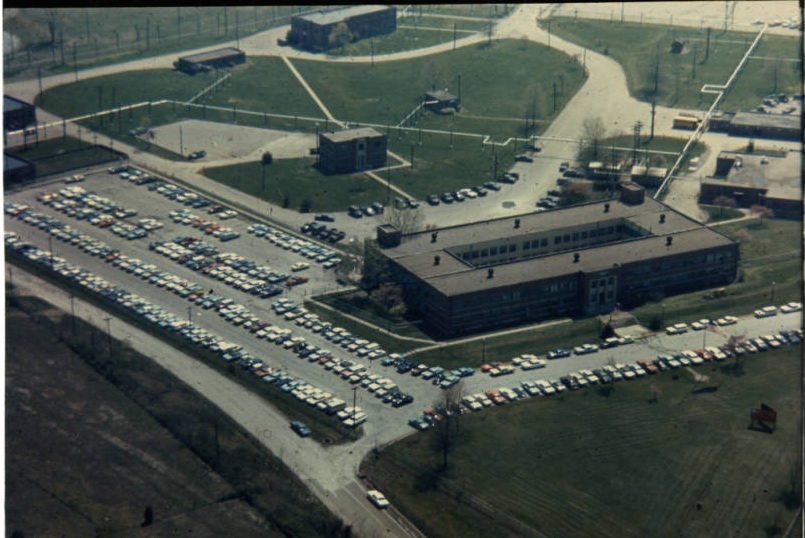 An environmental restoration program to clean up the facility began in 1994. By 2006 this initial decontamination process had been completed at a cost of $27.5 million.
An environmental restoration program to clean up the facility began in 1994. By 2006 this initial decontamination process had been completed at a cost of $27.5 million.
• Indiana Army Ammunition Plant disposal of lands agreement Aug 2003, Charlestown, Indiana
In 2004, the explosive decontamination program began. 901 structures were inspected and decontaminated. Various buildings were demolished by use of controlled burns to ensure the destruction of any powder remaining in the buildings. This phase cost $41.5 million.
• Indiana Army Ammunition Plant centralized geospatial data collection effort cycle 4 maps, May 2011
• Indiana Army Ammunition Plant overview report August 2016, Charlestown, Indiana
• Indiana Army Ammunition Plant 1940-2016 timeline, Charlestown, Indiana
September 2016 marked the end of the U.S. federal government's ownership of any of the land when it deeded the last piece of land to River Ridge Development. The U.S. Army officially left the facility 31 Oct 2016.
Currently in 2025, the land is known as River Ridge Commerce Center and is being used for newly built industrial warehouses and factories. Most of the original buildings from IOW and HOP have been torn down. The railroad tracks are being removed. Many of the original IOW Plant 1 brick buildings in the administration area are used as offices and retail space. The largest employer in Clark County is now located in this area. Once again, the area surrounding the facility is seeing an economic boom from the development.
Indiana Memory - digital collection of INAAP photographs
|
Indiana Ordnance Works photographs Hoosier Ordnance Plant photographs |
Indiana Arsenal photographs Indiana Army Ammunition Plant photographs |
Full INAAP digital collection on Indiana Memory

